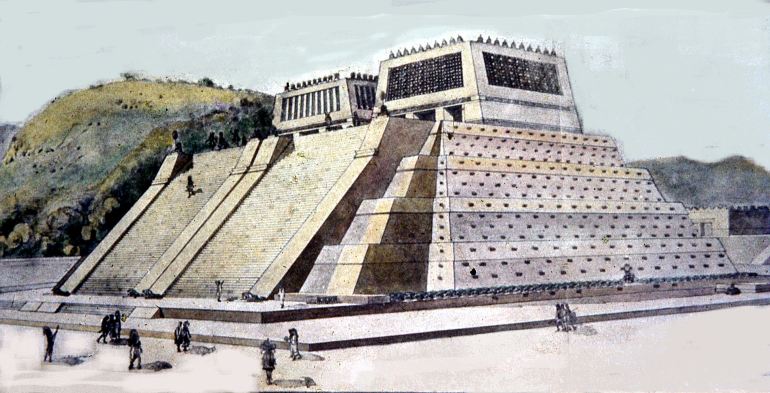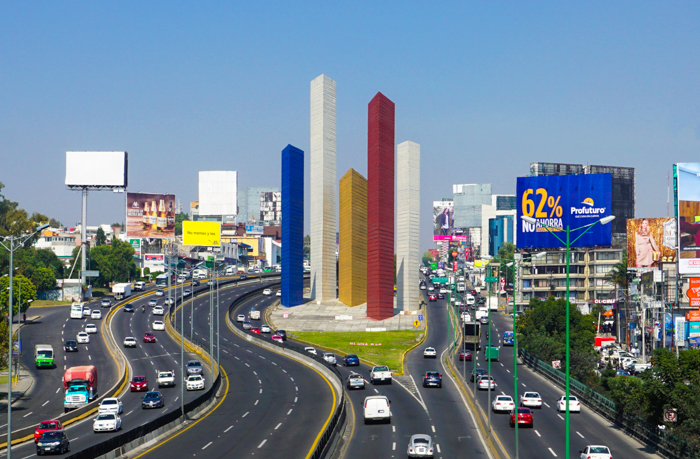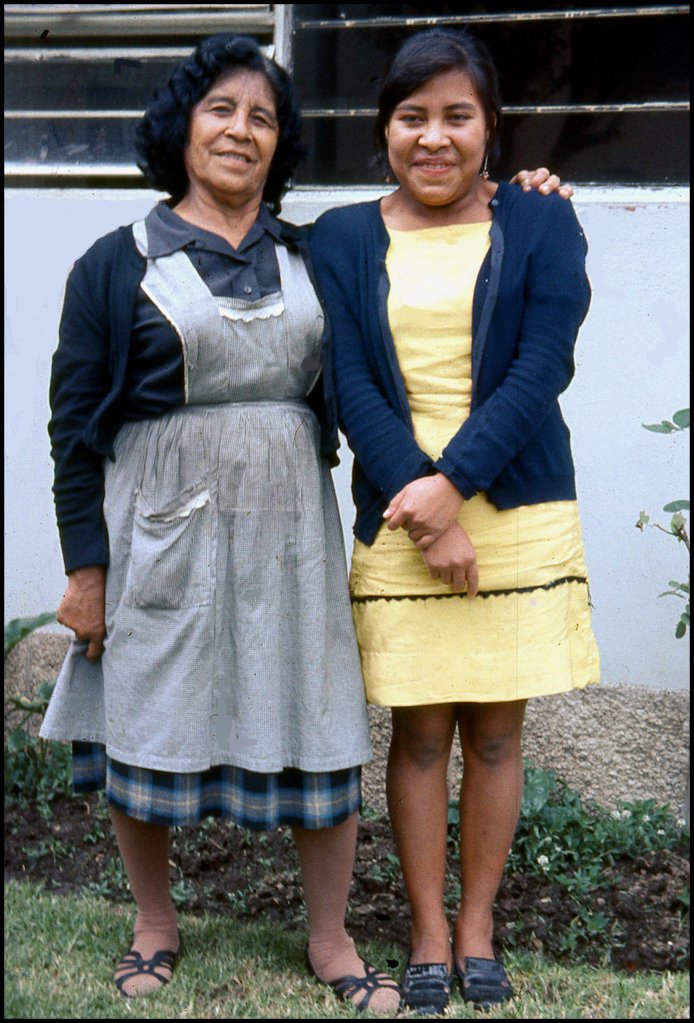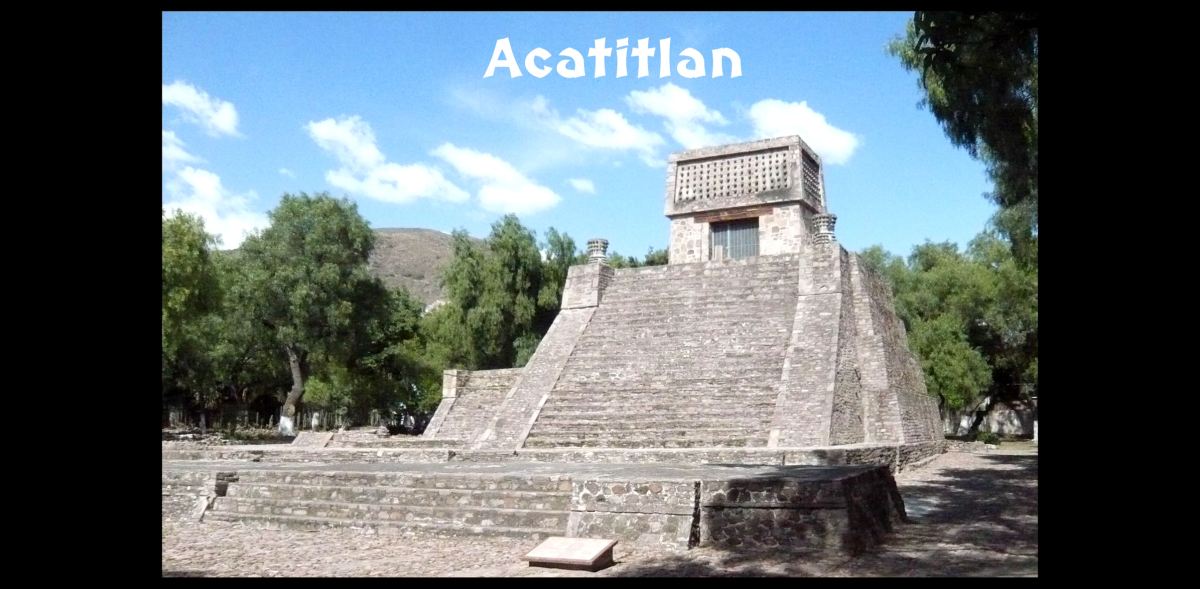by Richard L. Thornton, Architect and City Planner
One Summer In Mexico – Part Seven – July 8 & 11, 1970
Naucalpan y El Pedrigal, Estado de México
How could the Mexica (Aztecs) almost overnight go from being barbarians to sophisticated architects and town planners?
The color slide above is a metaphor for the total disorientation that I experienced while studying archaeological sites in metropolitan Mexico City. The terrain of the former lake beds is so flat and the urban fabric so dense that I generally had no clue where I was. The Public Relations Dept. at the Museo Nacional de Antropologia would give me travel directions . . . which Metro train and which buses . . . to reach a certain site, but most archaeological sites back then were not noted on street maps. I generally could not see the large volcanoes or tall buildings of El Centro when walking along sidewalks.


While accompanying the Sotos on one of their many auto trips to the Ciudad Satéllite mega-shopping center, I did buy a compass in the Outdoor Recreation shop at the Sears store. That at least told me the cardinal directions of ancient volcanoes that I could see from the tops of Aztec pyramids. However, it was only this week . . . 50 years later . . . that I realized that both Ciudad Satellite and Acatitilan were in the modern city of Naucalpan and that Tenayuca was in walking distance of Acatitlan. Notice the same low mountain behind both pyramids?

Dr. Piña-Chan had added six ancient cities to the section of my fellowship syllabus covering Mexico City. . . Tenayuca, Acatitalan, Naucalpan, Copilco, Tlatilco and Cuicuilco. Of these, only Cuicuilco was even mentioned in the Gringo anthropology textbook that I bought in the autumn of 1969, when preparing my proposal for the Barrett Fellowship. That section consisted of three paragraphs and a photo.
Sr. Soto had never seen Tenayuca, so he drove me to that pyramid the previous Saturday. He then took me to a traditional Mexican barbicoa, which featured lamb, wrapped in agave leaves, that was cooked in a pit of hot coals. An extremely picante (chilli hot) version of American barbecue sauce was then sprinkled across the meat. After one taste I skipped the hot sauce and put ketchup on the meat.

Acatitlan and Naucalpan
Four days later, I took the Metro subway to Acatitlan and Naucalpan. I came out of the ground not knowing a clue where I was. At that time, the Acatitlan pyramid was under reconstruction. There were no information signs, just an INAH construction sign. Fortunately, the supervising architect knew enough English that we could have a mixed English-Spanish conversation. That supervising architect was none other than Arq. Eduardo Luis Pareyón Moreno, who also happened to be Director of Reconstruction and Maintenance for the INAH. Eduardo said that he had reconstructed most of the Acatitlan pyramid in 1962, but now was adding details to the temple on top and repairing bad mortar. He had recently moved to Palenque to supervise major reconstruction projects there.
He said that we were standing where there had once been an island in marshes on the edge of Lake Texcoco. Humans had been living there a long, long time. A few artifacts and footprints had been found in the area, which suggested that humans had been there much earlier than the official time, 10,000 BC, when Clovis people officially populated the Americas. Some Mexican anthropologists thought that these people came around 15,000 or 20,000 years ago and that they were Polynesians. The Gringo archaeologists laughed at them.

The next group of people to arrive hunted large mammals like the mammoth and mastodon. Archaeologists had found large spear points used to hunt these animals and also places where the animals had been butchered.
The next people were farmers, probably from southern Mexico. They built earthen mounds and were probably related to the people of the Olmec Civilization.
The next people veneered the earthen mounds with field stones and made sophisticated ceramics. He thought that they were related to the people of Teotihuacan. Those towns were burned by the Chichimeca barbarians, when they conquered the Valley of Mexico.
The architect told me that something mysterious happened. The Chichimecs lived in crude huts made of saplings and grass. Then within a generation or two, they were constructing very sophisticated stone buildings that were different than anything that ever existed in central Mexico. They most resembled the temple pyramids of the Maya metropolis of Tikal in Guatemala, but were constructed differently. Traditionally, Mesoamerican pyramids were built in many layers over hundreds of years. The Mexica architects built strong outer walls then filled the holes with rubble. Afterward, the pyramids would be expanded by adding layers, like other Mesoamerican pyramids.

What we know today
Acatitlan: I now know that I was on what was then the northern edge of Metro Mexico City. Acatitlan is a Nahua word that means “Place Among the Reeds.” It is not known who built the original earthen pyramid at the site. Mexican anthropologists are now not even sure, who built the first stone pyramids at Acatitlan and Tenayuca. They know that the Tlatilica settled on the Hondo River that flowed into Acatitlan marshes around 1700 BC and that they shared many traits with the Olmec Civilization.* However, due to the extreme sparsity of skeletons, it is not known to what ethnic group they belonged. It is the same problem with the people, who were there before the Mexica. Artifacts suggest that they were not Chichimecs.
*The Wikipedia article on the Tlatilica calls them “Olmecs.” The Olmecs were a Nahuatl People, who invaded Tabasco around 1000 AD or later. They had no connection with the “Olmec Civilization.” The article also includes dubious information that Naucalpan was conquered by the Chichimecs around 1000 AD then conquered by the Otomi around 1200 AD. Anthropologists are not certain that the Otomi were still in the region after 1000 AD, but the Nahuatl Peoples had zero tolerance for other ethnic groups and certainly would not have tolerated the Otomi to rule a city state.
During the earliest period of Chichimec occupation of the Lake Texcoco Basin, Acatitlan was associated with Tenayuca, the political and religious center of the time. I now known that the two sites are about 3 Km or 1.8 miles apart. Along with Tenayuca, it was later conquered by the Mexica and became part of the so-called “Aztec Empire” under the rule of the cities of Tenochtitlan, Texcoco and Tlatilolco, until the arrival of the Spanish conquistadors in 1521.

Naucalpan: The name Naucalpan comes from Nahua and means “place of the four neighborhoods” or “four houses.” Acatatitlan is one of the four principal archaeological sites in Naucalpan, which seem to share a common archaeological heritage. This was not the case in 1970 when all of these sites were assumed to have always been Nahuatl after around 1000 AD, but were given separated cultural identities.

Becoming a part of a social revolution
I woke up Saturday morning after my first date with Alicia the night before . . . thinking of Alicia. I wished that she could be in my arms at that very moment. HOWEVER, 1970 protocol in both the US and Mexico stated that I should wait till early afternoon to call Alicia and thank her for the evening. I should then invite her to join me at some public location, where physical contact was impossible. That was to show her that I was not merely interested in her body. So much for my grand plans.
It generally took, Señora Soto, Gionela and Ruth anywhere from 30 minutes to an hour each morning to put on makeup. It took Alicia one minute to put on lipstick and one minute to brush her beautiful black hair. She really didn’t even need lipstick.

So, I was at the breakfast table sipping tea, while Sr. Soto was sipping coffee, when the phone rang. Normally, one of the servants would answer the phone, but Eufamia was at the panaria buying fresh bolillos (breakfast rolls) and Santos was cooking breakfast.* Sr. Soto walked over to the phone and answered it.
*As was the custom of the racist South, when I was a kid, indigenous servants in Mexico were addressed by their first name, whereas all members of the family they served were addressed by their title (Sr/Sra/Sta, etc) plus their family name.

A big smile came to his face as he talked to the caller. I heard my first name mentioned several times. Sr. Soto grinned ear to ear as he handed me the phone. “Ricardo, it is A-lic-c-c-cia. She likes you very much. She says that she can talk about anything with you.”
Alicia had a speech prepared when I jumped into the car. She initially announced that she hated the way men and women related to each other in Mexico. The boys she had dated spent all Friday night at a burdel (brothel) then brought her flowers on Saturday night then spent all the rest of the week with other men. She wanted her man to be her best friend and her companion for “little things” of life, while she wanted to be HIS only lover . . . as often as possible. She was inviting me to go to an arts and craft shop, where she needed to buy paint for an art class at the university. Did I dislike doing “little things” with women?
I told her that I have never done that before, but it sounds like fun. We only see girls for Saturday night dates. They wouldn’t dream of going on a date to a supermarket.
She responded, “Good! When I go to the supermercado (supermarket) I will also invite you along. Now, since my mother is out of town, one of my married cousins has invited me to stay at her hacienda near Cuernava this afternoon and tomorrow. Would you like to come with me?
The old house has ghosts and I need you to protect poor little Alicia at night from the ghosts. My cousin said that she would enjoy having you as a guest. Her husband will not be there . . . probably with his stupid blond mistress in Puebla . . . Maybe with a new puta (prostitute).”
“My cousin is always so sad and lonely, except when I come to visit. She is 26, very pretty and very nice, but she might as well be a nun. The men in the family will not let her get a divorce. They said that they would rather see her dead than divorced. I would share you with her, except Alicia is selfish . . . well, maybe later in fifty years, when you are tired of me.” She winked.
Alicia then pulled the car to the side of the street and parked. She then planted a passionate kiss and confessed that she awoke with the same desire as me. So much for me going slow after the first date.
Before heading on the expressways to Cuernavaca, Alicia stopped by the Soto house for me to get my things. Turns out that Alicia has already gotten permission from Sr. Soto for me accompany her to Cuernavaca. He said that I did not need permission, but he thanked her for letting him know where I would be. BUT – there was now a note to call her aunt, waiting for her at the Soto house. Her cousin had unfortunately called her mother (one of Alicia’s aunts) to relate her excitement about having a Gringo visitor. Alicia had apparently given the impression that we were practically engaged. The aunt was not pleased. Under no circumstances was Alicia to bring me to Cuernavaca. Alicia’s 10-year old cousin, Carmenita, was accompanying her to Cuernavaca, instead.

Copilco
Since I could not go with Alicia to Cuernavaca, I decided to take the Metro to Copilco. It was a waste of time. I came out of the ground to see a Copilco Station Metro sign, plus a small multi-lingual sign, put up for the 1968 Olympics, which told me less than what I already knew.
There is nothing to see at Copilco. The ancient town was covered by lava like Pompei and Herculeneum and Pompei. Eventually, a Chichimec tribe known as the Tepaneca built a town on top of the lava, but their edifices have all been destroyed by Colonial Era and modern development. Copilco is extremely famous for its figurines of young women, though. Some were on the shelves of Dr. Román Piña-Chan’s office.
Copilco was one of the earliest and important ceremonial centers in the Valley of Mexico. It was located on the shores of Lake Texcoco like Tenayuca. In the mid-Preclassical (800 BC), several villages developed in this place and slowly evolved and grew, becoming cities and eventually major civic-ceremonial urban centers in the late-Pre-Classical period (c. 100 AD).
The people of Copilco had very similar lifestyles to those of the so-called Mississippian Culture in the Southeastern United States. In fact, there is a strong possibility that Muskogeans originated in this culture. The people of Copilco raised a variety of crops, but maize was the most important. They also hunted and fished like the people of the Southeast, but not like later civilizations in the Valley of Mexico. As a result, the residents of Copilco had better diets with much more protein than later peoples.
Copilco’s decline began early in the 1st century BCE, with the increasing rise of Teotihuacán as an important population, cultural and religious center. Around 400 CE, the Xitle volcano erupted, burying Cuicuilco and Copilco. Lava spread over a vast area of what today is known as “Pedregal de San Ángel”. Agriculture was impossible in the Pedregal and so no new indigenous cities or villages developed there. It is now a highly prestigious residential neighborhood that looks very much like the most posh neighborhoods of the Island of Hawaii. Mexico was NOT what I expected it to be.


Howdy, As usual always new information.
On Sun, Jul 12, 2020 at 12:35 PM The Americas Revealed wrote:
> alekmountain posted: ” by Richard L. Thornton, Architect and City Planner > One Summer In Mexico – Part Seven – July 8 & 11, 1970 Naucalpan y El > Pedrigal, Estado de México How could the Mexica (Aztecs) almost overnight > go from being barbarians to sophisticated archi” >
LikeLiked by 1 person
Another compelling and as always, colorful life read. Enjoy how you succeed in weaving modern day life tales or histories inside of details of historical places and subjects relevant to many eras and how humanity has traveled to and fro over many centuries. I very much enjoy looking at maps of the areas of Southeastern U.S. but in the 1500s through the 1700s with the names of Indian villages instead of European settlements to really absorb how in the same way we go from town to town on maps of our own, there was at one time similiar experiences for people of those times. Different of course, but comparable in some basic life ways. Reading your blog often leaves me wishing to be in your head as you no doubt have a greater grasp of how these “maps” of history so to say existed at different times. I fear it reminds me that we are not classically educated as a people and somehow more, if not all of us, from the time we are young, should be involved in these sorts of pursuits of discovery and sourcing the history of the world’s peoples. Its troublesome. I wonder if many of the world’s ills could be remedied just by being in pursuit of such learning. All the same, your blog and writing keeps me optimistic and inspired for a greater society. Thank you.
LikeLiked by 1 person
Well, Drumshawdower, you really stoke my ego. It is not so much a classical education, but the intellectual curiosity of a child that drives me forward.
LikeLike
Richard, I see the “new world order” flag flying high and proud in Mexico and America. Meru is a place of Gold…Ica means sprit..so America means “a gold sprit” in ancient Indo-European veridic. The history we have been taught by the New world order folks traces back to Sparta / Roman ( Eagle/serpent symbol) enslaver minded men of Europe. All the written history we have of Mexico is from post conquest men of Rome. I’m glad the court ruled in favor of the Native nations in Oklahoma…however they also ruled we don’t have “any property rights” the Government can’t take away.
LikeLiked by 1 person